英语教学案例(Unit10 Where did you go on vacation Period 3)
- 格式:doc
- 大小:55.00 KB
- 文档页数:3
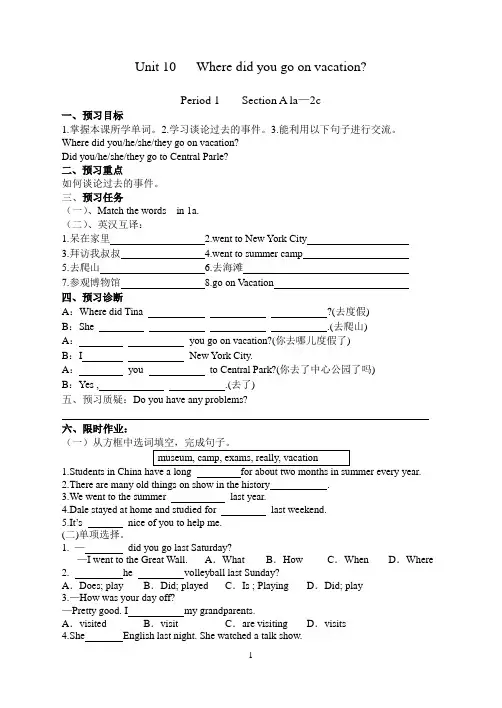
Unit 10 Where did you go on vacation?Period 1 Section A la—2c一、预习目标1.掌握本课所学单词。
2.学习谈论过去的事件。
3.能利用以下句子进行交流。
Where did you/he/she/they go on vacation?Did you/he/she/they go to Central Parle?二、预习重点如何谈论过去的事件。
三、预习任务(一)、Match the words in 1a.(二)、英汉互译:1.呆在家里2.went to New Y ork City3.拜访我叔叔4.went to summer camp5.去爬山6.去海滩7.参观博物馆8.go on V acation四、预习诊断A:Where did Tina ?(去度假)B:She .(去爬山)A:you go on vacation?(你去哪儿度假了)B:I New Y ork City.A:you to Central Park?(你去了中心公园了吗)B:Y es , .(去了)五、预习质疑:Do you have any problems?六、限时作业:for about two months in summer every year.2.There are many old things on show in the history .3.We went to the summer last year.4.Dale stayed at home and studied for last weekend.5.It’s nice of you to help me.(二)单项选择。
1. —did you go last Saturday?—I went to the Great Wall. A.What B.How C.When D.Where 2. he volleyball last Sunday?A.Does; play B.Did; played C.Is ; Playing D.Did; play3.—How was your day off?—Pretty good. I my grandparents.A.visited B.visit C.are visiting D.visits4.She English last night. She watched a talk show.A.didn’t study B.didn’t studied C.doesn’t study D.don’t study5.A lot of people come to Qingdao vacation every year.A.in B.on C.with D.atUnit 10 Where did you go on vacation?Period 2 Section A 3a—4一、预习目标1.掌握本课所学单词。
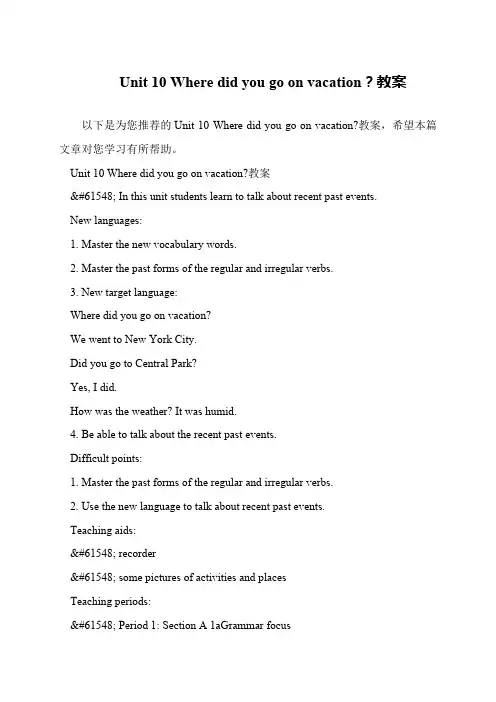

unit10wheredidyougoonvacation教案(⼈教新⽬标初⼀)unit10wheredidyougoonvacation教案(⼈教新⽬标初⼀)单元整体讲明单元教材分析本单元是九年制义务课程标准实验教科书?新⽬标英语?七年级下册第10单元本单元的核⼼话题是⽤⼀样过去时谈论度假等发⽣在过去的情况。
因此〝Where did you go on vacation?" " Did you go to the beach? Yes,I did.No,I didn’t.〞等是教学的重点。
通过对本单元的学习,学⽣能把握本单元显现的地点名词,⽤于询咨询和回答过去发⽣的情况的短语和句型。
单元知识结构词汇:New York City; CentralPark,exam,were,rainy,delicious,expensive,inexpensive.crowded.flew,kite,later,felt,little, corner, discuss,etc 句型: Where did you go on vacation? I went to summer camp.Did she go to Central Park?Yes,she did.No, she didn’t语法:⼀样过去时专门疑咨询句、⼀样疑咨询句及肯、否定回答。
单元总体⽬标1.Master the vocabulary2.Master and use:Where did you go on vacation? I went to summer camp·Did she go to Central Park?Yes,she did.No, she didn’t单元教学重难点⼀览单元学情分析学⽣在第五单元已接触过⼀样过去时,具有了学习本单元知识的认知前提,能⾃然地与本单元话题进⾏衔接。
假期活动Such as; go abroad, go hiking, go hiking, summer camps, and so on接近学⽣的⽣活,They are all interested in talking about it.单元教学建议第⼀进⾏集中识字,为本单元的学习作好铺垫。
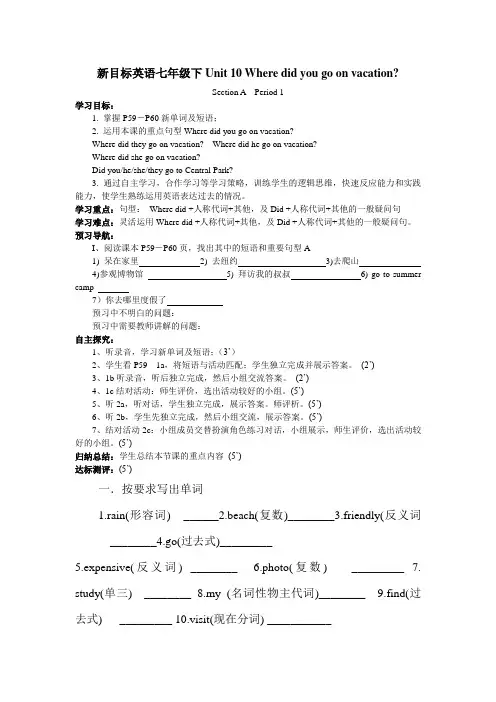
新目标英语七年级下Unit 10 Where did you go on vacation?Section A Period 1学习目标:1. 掌握P59-P60新单词及短语;2. 运用本课的重点句型Where did you go on vacation?Where did they go on vacation? Where did he go on vacation?Where did she go on vacation?Did you/he/she/they go to Central Park?3. 通过自主学习,合作学习等学习策略,训练学生的逻辑思维,快速反应能力和实践能力,使学生熟练运用英语表达过去的情况。
学习重点:句型:Where did +人称代词+其他,及Did +人称代词+其他的一般疑问句学习难点:灵活运用Where did +人称代词+其他,及Did +人称代词+其他的一般疑问句。
预习导航:I、阅读课本P59-P60页,找出其中的短语和重要句型A1) 呆在家里2) 去纽约3)去爬山4)参观博物馆5) 拜访我的叔叔6) go to summer camp7)你去哪里度假了预习中不明白的问题:预习中需要教师讲解的问题:自主探究:1、听录音,学习新单词及短语;(3’)2、学生看P59 1a,将短语与活动匹配;学生独立完成并展示答案。
(2’)3、1b听录音,听后独立完成,然后小组交流答案。
(2’)4、1c结对活动:师生评价,选出活动较好的小组。
(5’)5、听2a,听对话,学生独立完成,展示答案。
师评析。
(5’)6、听2b,学生先独立完成,然后小组交流,展示答案。
(5’)7、结对活动2c:小组成员交替扮演角色练习对话,小组展示,师生评价,选出活动较好的小组。
(5’)归纳总结:学生总结本节课的重点内容(5’)达标测评:(5’)一.按要求写出单词1.rain(形容词) ______2.beach(复数)________3.friendly(反义词________4.go(过去式)_________5.expensive(反义词) ________6.photo(复数) _________7. study(单三) ________8.my (名词性物主代词)________9.find(过去式) _________ 10.visit(现在分词) ___________二、根据句意及首字母填单词1.Why did you s________ at home?2.There was not too much to see, the museum was b___________.3.The vacation was r_________ , I feel great.4.Where did you go? I v__________ a museum.5.She studied for the e__________ yesterday.三、单选( )1.Today we _________ the Great Wall, I think it’s great.A. visitsB. to visitC. visitingD. visited( )st Sunday we went to the beach . We had great fun __________ in the water.A. playingB. playsC. playD. to play( )3.It ________ rainy and windy on April 10th , I stayed at home all day.A. isB. wasC. areD. were( )4.What did the foreigners _________ their vacation?A. think ofB. think forC. think overD. think of as( )5.My mother and I _________ at my home _________ that snowy night.A. were, atB. was, atC. were, onD. was , on拓展提高:按要求改写句子。
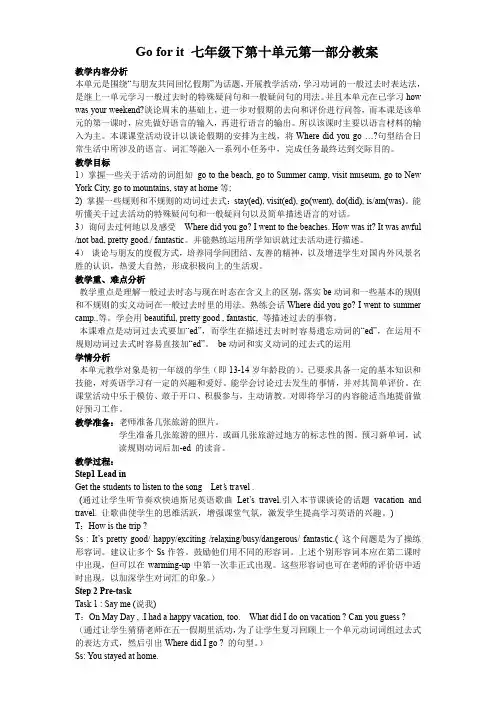
Go for it 七年级下第十单元第一部分教案教学内容分析本单元是围绕“与朋友共同回忆假期”为话题,开展教学活动,学习动词的一般过去时表达法,是继上一单元学习一般过去时的特殊疑问句和一般疑问句的用法。
并且本单元在已学习how was your weekend?谈论周末的基础上,进一步对假期的去向和评价进行问答,而本课是该单元的第一课时,应先做好语言的输入,再进行语言的输出。
所以该课时主要以语言材料的输入为主。
本课课堂活动设计以谈论假期的安排为主线,将Where did you go …?句型结合日常生活中所涉及的语言、词汇等融入一系列小任务中,完成任务最终达到交际目的。
教学目标1)掌握一些关于活动的词组如go to the beach, go to Summer camp, visit museum, go to New York City, go to mountains, stay at home等;2) 掌握一些规则和不规则的动词过去式:stay(ed), visit(ed), go(went), do(did), is/am(was)。
能听懂关于过去活动的特殊疑问句和一般疑问句以及简单描述语言的对话。
3)询问去过何地以及感受Where did you go? I went to the beaches. How was it? It was awful /not bad, pretty good./ fantastic。
并能熟练运用所学知识就过去活动进行描述。
4)谈论与朋友的度假方式,培养同学间团结、友善的精神,以及增进学生对国内外风景名胜的认识,热爱大自然,形成积极向上的生活观。
教学重、难点分析教学重点是理解一般过去时态与现在时态在含义上的区别,落实be动词和一些基本的规则和不规则的实义动词在一般过去时里的用法。
熟练会话Where did you go? I went to summer camp..等。
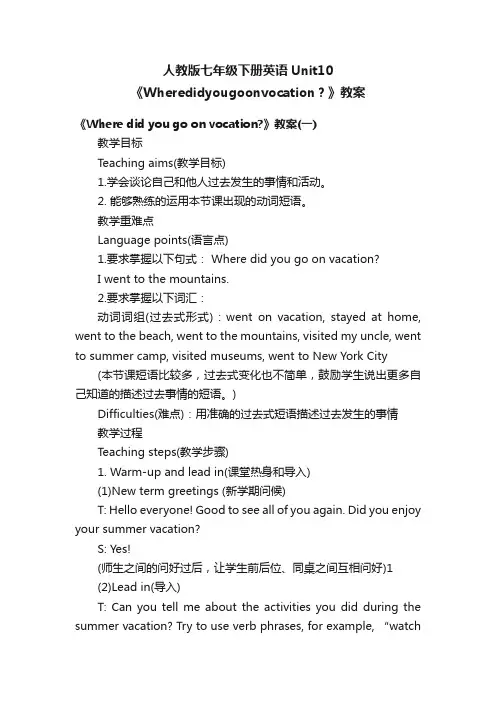
人教版七年级下册英语Unit10《Wheredidyougoonvocation?》教案《Where did you go on vocation?》教案(一)教学目标Teaching aims(教学目标)1.学会谈论自己和他人过去发生的事情和活动。
2. 能够熟练的运用本节课出现的动词短语。
教学重难点Language points(语言点)1.要求掌握以下句式: Where did you go on vacation?I went to the mountains.2.要求掌握以下词汇:动词词组(过去式形式):went on vacation, stayed at home, went to the beach, went to the mountains, visited my uncle, went to summer camp, visited museums, went to New York City (本节课短语比较多,过去式变化也不简单,鼓励学生说出更多自己知道的描述过去事情的短语。
)Difficulties(难点):用准确的过去式短语描述过去发生的事情教学过程Teaching steps(教学步骤)1. Warm-up and lead in(课堂热身和导入)(1)New term greetings (新学期问候)T: Hello everyone! Good to see all of you again. Did you enjoy your summer vacation?S: Yes!(师生之间的问好过后,让学生前后位、同桌之间互相问好)1(2)Lead in(导入)T: Can you tell me about the activities you did during the summer vacation? Try to use verb phrases, for example, “watchTV”.S1: I went shopping.S2: I went to the movies with my friends.S3: I went swimming.(老师可以鼓励学生给出尽可能多的答案,并引导学生使用过去式) T: Wow. It sounds like you had a good time during the summer vacation! I’m sure you enjoyed yourselves very much. Now I want to know where you went on vacation.(教师把“Where did you go on vacation?”和I went/… 板书在黑板上)教学设计说明:从贴近学生熟悉的话题入口,通过对学生暑假生活的了解及回顾,引出今天的重点内容。

Unit 10 Where did you go onvacation?Topic: Holidays and vacationsFunctions: Talk about past eventsStructures:Past tense of regular and irregular verbswas / wereHow questionsTarget language: Where did you go on vacation?We went to New York City.Did you go to Central Park?Yes, I did.How was the weather?It was humid.Teaching StepsPeriod 1Good morning everyone! We have finished Unit 9. Today we are going to learn a new unit—Unit 10.Step 1: Lead inAsk and answera. Can you tell me what the title of Unit 10 is? Yes, it’s Where did you go on vacation? What do you think the unit is about?b. Yes. In this unit we are going to talk about past events.Step 2: Section A 1aIn Unit 9, we talked about the recent past activities and in this unit, we are going to continue talking about the past events.First, please open your books at Page 59 and look at activity 1a.1. Look and findLet’s look at activity 1a and find what the phrases mean.2. MatchYou know what the phrases mean. Please match them with the pictures.3. Check the answersHave you finished? Let’s check the answers one by one.Answers: 1. e 2. b 3. d 4. c 5. a 6. f 7. g4. Reada. Please read the phr ases after me. Stayed at home …b. Let’s read them together.c. Would you please read them one by one?Step 3: Section A 1b1. Listen and numberListen to the tape. And number the people from 1 to 5 in the picture. 2. Check the answersLet’s check the answers.Answers: 1. went to the mountains2. visited my uncle3. stayed at home4. went to New York City5. went to summer camp3. Reada. I would like you to read the conversations together.b. Would you please read them by yourselves three times?c. This time I would like you to read them twice with your partner.d. Who would like to read in class?Step 4: Section A 1cPairwork1. ReadWould you please read the conversation in 1c with your partner?2. Practicea. Would you please make conversations with your partner to talk about where the people went on vacation in activity 1a?b. Who would like to have a try in class?Step 5: Section A 2a1. ListenNow class, let’s move to activity 2a now. Please listen to the tape for the first time.2. MatchWhere did Nancy, Kevin and Julie go on vacation? Please match the person with the place when you listen to it for the second time.3. Check the answersHave you finished? Please check your answer with your partner and see whether your answers are the same. Let’s check them together.Answers: 1. c 2. a 3. bStep 6: Section A 2b1. Listen and checka. Listen to the conversation for the first time.b. Please check (√) “Yes, I did.” or “No, I didn’t.” for each question as you hear them talk.2. Check the answersHave you finished? Let’s check them.Answers: go to Central Park? Yes, I did.play volleyball? No, I didn’t.swim? Yes, I did.go to the movies? No, I didn’t.study for exams? Yes, I did.3. Reada. Let’s read the conversations together.b. I would like you to read them by yourselves.c. Who would like to have a try to read them in class?Step 7: Section A 2cGroupworka. Now class, let’s move to activity 2c.It’s a groupwork. Would you please role play conversations between Nancy, Kevin, and Julie?b. Who would like to have a try in class?c. Well done. Please pay attention to the past forms of the verbs in the phrases.Step 8: Grammar Focus1. ReadRead the sentences in the grammar box.2. Point out the notesSimple past tense Regular verbs Irregular verbsStep 9: SummarizeLet’s summarize what we learnt in this period.Step 10: Homework1. Copy the words in activity 1a and the sentences in the grammar box.2. Practice activity 2a and 2b.Period 2Step 1: Lead inWhat did we learn in Period 1? Who can tell us? Yes. We got to know how to talk about past events. Besides them, we learnt some regular verbs and some irregular verbs. Do you still remember how to say them? OK. Let’s review them first.Step 2: Revision1. Ask and answera. Would you please translate my Chinese into English? 拜访我的舅舅、参观博物馆……b. Please practice in pairs. Student A says in Chinese and student B translates it into English.2. DictationPlease take out your dictation exercise books and let’s have a dictation.Step 3: Section A 3a1. FillNow, let’s move to a new part of lessons. Would you please look at activity 3a on Page 61? Fill in the blanks with “was” or “were” in the c onversation.2. Check the answersI think all of you did well.Answer: 1. was 2. was 3. were 4. were 5. was 6. was 7. were 8. were3. Reada. Read the conversation with your partner.b. I would like you to read it together.c. Would you like to read it in class? Please have a try.4. Explainpretty good fantastic unfriendlyStep 4: Section A 3bPairworka. Just now, we learnt how to ask about the vacation. Now, I would like you to do a pairwork to ask and answer questions about the people’s vacations in 3b. Please follow the example in 3a.b. Who would like to have a try in class?Step 5: Section A 4Game—Vacation albumJust now, we talked about some people’s vacations. How about your vacations? Please make a photo album of vacations you enjoyed. Show the album to your classmates and talk about your vacations.Step 6: SummarizeLet’s summarize what we learnt in this period.Step 7: HomeworkCopy and try to recite the conversation in 3a.Period 3Step 1: Lead inGood morning, boys and girls. Shall we continue our lessons? Could you please tell me what we learnt in Section A? Yes. We learnt to talk about the weekend.Step 2: RevisionReviewa. I will show you some pictures and some information and please make conversations.b. Let’s have a dictation.Step 3: Section B 1a1. Looka. In Section A, we talked about the vacations with some description words. In Section B, we are going to learn more description words.b. Open your books at Page 62. Would you please look at activity 1a?c. Look at the words and the pictures.2. MatchPlease match the words with the pictures.3. Check the answersHave you finished, everyone? Let’s check them together.Answers: 1. f 2. a 3. d 4. e 5. b 6. cStep 4: Section B 1b1. WriteLet’s move to activity 1b. Do you think the words in 1a are happy words or unhappy words? Write happy words on the left and write unhappy words on the right.2. Check the answersCheck the answers with your friends.Answers:Happy words: delicious, cheap, not crowdedUnhappy words: awful, expensive, crowdedStep 5: Section B 2a1. Listen and answera. Let’s move to activity 2a now. It is a listening exercise. For the first time, I would like you to listen only.b. Now, for the second time, please listen to it again and answer the questions in activity 2a.2. Check the answersI think most of you have finished it. Let’s check them together.Answers: 1. She went to Tokyo.2. Yes, she did.Step 6: Section B 2b1. ListenListen to the conversation for the first time.2. Listen and filla. Listen to the conversation again and fill in the chart.b. Listen to the conversation again and check them by yourselves.3. Check the answersLet’s check the answers together.Answers: vacation: greatmuseums: interesting, crowdedstores: expensivepeople: friendlyfood: delicious4. Read the tapescripta. Let’s read the tapescript together.b. Would you please read the tapescript in pairs?c. Please translate the conversation into Chinese in pairs.d. Who would like to read in class?Step 7: Section B 2cPairworkRole play. Student A is Vera’s friend. Student B is Vera. Talk about Vera’s vacation. Use the information in the chart above. Student A begins questions with these words: Where did …? What did …? Did you …? How was …? How were …?Step 8: SummarizeLet’s summarize what we learnt in this period.Step 9: HomeworkPractice activity 2a and 2b in Section B.Period 4Step 1: Lead inWe have finished the most part of Unit 10. And in this period, we will continue to finish Section B. But before that, I would like you to review what we learnt before.Step 2: Revisions1. Make a speechCan you make a speech according to the chart to tell us your vacation?2. DictationLet’s have a dictation.Step 3: Section B 3a1. Reada. Let’s go into activity 3a on Page 63. There is a diary from Bob.b. Please read it by yourselves. If you have any questions, please ask me.c. I would like you to read it together.2. Circle and underlinePlease circle the good things about his vacation and underline the bad things.3. Check the answersI think most of you have finished. Please check your answers with your partner.Answers:Circled items: the weather (great)the beach (beautiful)playing in the water (fun)helping the little boy find his father (happy)playing tennis (really fun)eating Sichuan food (delicious)Underlined items: shops were too crowded (didn’t really enjoy them)museum (kind of boring)no money for taxi / walking back to hotel (tired)4. ExplainLet me explain some key words and phrases to you.all day have a fun doing sth. be crowded kind of find sb. doing sth. be lost help sb do sth. make sb. do sth. walk back to decide to do sth. all morning for dinnerStep 4: Section B 3b1. WriteImagine you are an American student on vacation in Beijing. Would you please write a travel diary according to the pictures given below?2. Reada. Please read your diary to your partner.b. Who would like to have a try to read it in class?Step 5: Section B 4GroupworkImagine you are all foreigners on vacation in China. You meet each other at the airport on your way home. Talk about what you did on your vacation.Step 6: SummarizeLet’s summarize what we did in this period.Step 7: HomeworkTry to recite the article in 3a.Period 5Step 1: Lead inWe have spent four periods on Unit 10. This is the last period of Unit 10. In this period, we will do some exercises and make sure you learn this unit well.Step 2: Self-check-11. Check the words and the phrases you knowOpen your books and look at Self-check-1. If you know the words and the phrases well, please check them.2. ReadI would like all of you to read the words and the phrases together.Step 3: Self-check-21. Do you have any other words you don’t know? Please write them in your exercise books.2. Please ask your friends for help.3. Looking up the dictionary is also a good way to study English. I hope you can get more from dictionaries.Step 4: Self-check-31. CompleteLet’s move to Self-check-3 now. First, I would like you to complete the form below.2. Make a surveya. Make questions about vacations. Write some questions about vacations.b. I would like you to ask your partner the questions you write and write down their answers.c. Discuss the best place for a vacation with your classmates.3. WriteWrite a report on student s’ vacations.Step 5: SummarizeLet’s summarize what we did in this period.Step 6: Homework1. Do the exercises on the Students’ Book and the textbook.2. Review Unit 10.3. Watch the pictures in Just for fun on Page 64.这份文件是人教版七年级英语《Unit 10 Where did you go on vacation?》的教案,主要涵盖了五个教学周期(Period)的内容,每个周期都详细规划了教学目标、教学活动、教学方法以及课后作业。
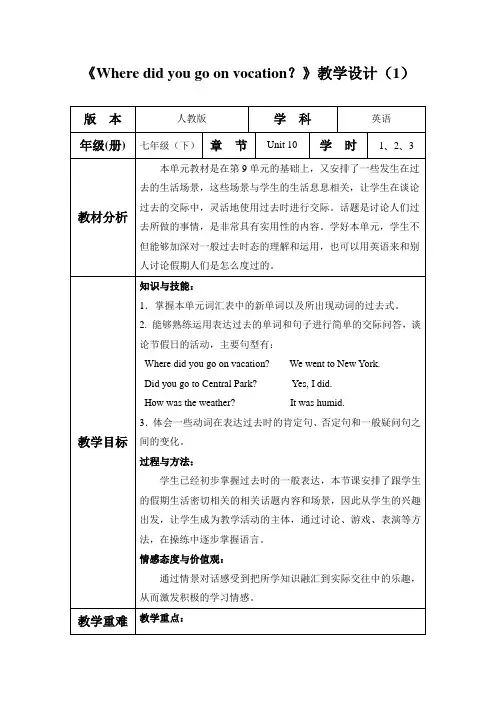
《Where did you go on vocation?》教学设计(1)教学过程:Step1:Lead-in1. Free talk.Greet the class as usual. (Talk about the weather. Use Present tense and Past tense. )T: How’s the weat her today?S: It is…….T:How was the weather yesterday?S: It was……(Talk about the Past Tense )T: What did you do last weekend?S: I watched TV.……【设计说明】强化口语交际能力,检查复习所学知识。
2. Play a short video (movie clips), after then, Ask Ss to talk about what the people did in the video.【设计说明】播放学生比较熟悉的影片片断,让学生观看后根据记忆描述剧中人物进行的活动(运用过去时表达)。
比比看谁的记忆又快又准。
Step2: Presentation1. Show some pictures of the new words on the screen. Ask students to try to read these words.Summer camp, museum, guide, beach, mountain【设计说明】通过多媒体屏幕向学生展示新单词, 图文并茂,非常直观地向学生展示了新单词。
简单的单词游戏既调动了学生的学习积极性又强化了单词记忆。
2. Draw attention to the picture of 1a, ask Ss to name each activity.3. Read the numbered list of activities, let Ss to repeat, and then match the activities with pictures.【参考答案】e, b, d, c, a, f, g.【设计说明】熟悉新的词组,了解读音,为下面的听力练习打好基础。
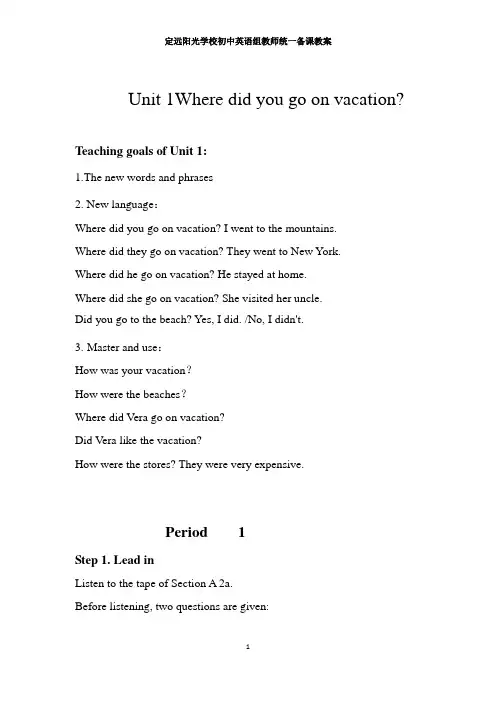
Unit 1Where did you go on vacation?Teaching goals of Unit 1:1.The new words and phrases2. New language:Where did you go on vacation? I went to the mountains.Where did they go on vacation? They went to New York.Where did he go on vacation? He stayed at home.Where did she go on vacation? She visited her uncle.Did you go to the beach? Yes, I did. /No, I didn't.3.Master and use:How was your vacation?How were the beaches?Where did Vera go on vacation?Did Vera like the vacation?How were the stores? They were very expensive.Period 1Step 1. Lead inListen to the tape of Section A 2a.Before listening, two questions are given:What did they talk about?What did they do on vacation?Step 2.Task oneshow one’s own vacation acti vities.Ask some Ss to use the pictures they prepared before class and describe their vacation tour.Teacher try to catch the verbs they use and write them down on the blackboard, point out the past form of these verbs.Step 3.Pair work and presentation.Brain storm: let students speak out the vacation activities they know by using the past form of the verbs.Step 4.Task twoMy classmates’ vacationListen to the tape of Section B2a,ab.Step 5.Class workStep 6.Task three: decide on next vacation destination. Compare the information you got from the classmates, decide where you want to go and state why.Step 7.ReportI decided to go to …Mary went there last summer vacation. The weather there was …the food …I think it was …So I want to go there next vacation.Step 8Homework:write down your final choice and state whyperiod 2Step 1. OrganizationOrganize Ss by saying hello to each other.Step 2. PresentationAsk questions about what students did last SaturdayT: Who went to the movies last Saturday?Ss: Sara went to the movies last Saturday.(Repeat. Underline the word “went”.)T: Who visited a friend last Saturday?Ss: Carlos visited a friend last Saturday.(Repeat. Underline the word “visited”.)Step 3. PracticePoint to the numbered list of activities.Say each one again and ask the students to repeat.Ask Ss to match each phrase with one of the pictures.Say,Write the letter of each picture next to the name of the activity.Point to the sample answer.step 4. ListeningThis activity gives students practice in understanding the target language in spoken conversation.The people talk about what they did on vacation.listen to the recording and write numbers of the names in the right boxes in the picture. Please write only 5 numbers. Point out the sample answer next to the pictureshowing went to the mountain.Correct the answers.Step 5. Pair workPoint out the example conversation. Ask two students to read the dialogue to the class. Say,Now work with a partner. You’re your own conversation about the pictures.Say the dialogue in the picture with a student,Do a second example to the class.4. Have students work in pairs.As they talk,move around the room monitoring their work.Offer language or pronunciation support as needed.Step 6. Grammar Focus1. Review the grammar box. Ask Ss to say the questions and answers.2. Review the difference between regular –ed past tense verbs (stay –stayed, visited).Step 7 HomeworkPractice the dialogue according to the picture on Page 1period 3Step 1.PresentationPoint out the pictures in the photo album. Ask students to describe what they see.Step 2. Practice1.Read the first two lines of the dialogue to the class.Point out the answer was in the first line. Then point out the blanks in the rest of the lines of the dialogue.Read the conversation to the class saying the word blank for each blank line: How blank the beaches? Ask students to complete the activity on their own.2. Point to picture 3 and ask students to say what they see. Then read the words under the picture.Pronounce any new words and explain what they mean.3. Say a dialogue with a student.Point to the food picture. Ask,How was the food? Do a send example,if you wish.Move around the room monitoring their work.Offer language or pronunciation support as needed.Have two students perform the example conversation,or perform it yourself with one student.B: It was hot and humid.4. Point out that the conversations starts off with the sentences in the speech bubbles.For example,A:where did you go?B: I went to…A: What was the weather like?Step3. PairworkFirst fill in the chart with the information about your last vacation,Say where you went,what the weather was like, what you ate,and what else you did.As students fill in the chart move around the classroom, monitoring progress and offering help as necessaryStep 4 Home workMake a conversation and actPeriod 4Step 1. OrganizationOrganize Ss by greeting each other.Step 2. PresentationPoint to the picture, This is a ring. The price is one hundred million dollars.Say:It’s expensive.Step 3. WritingPoint out the six words delicious,awful,expensive,inexpensive, crowded 1.Say each word and ask students to repeat them,2.Call attention to the fourth picture saying: This is a cake.It’s delicious!Then do the same thing for all six pictures.crowded delicious3.Then point out the blank line in front of each numbered word.4.Point out the sample answer. As students work,move around the room answering questions as needed.Practice in pairs thenStep 4. ListeningPlay the recording the first time. Students only listen.This time say, listen to the recording and write the answer to each question.Play the recording a second time.Ask students to finish filling in their answers and to check their answers.then discuss the keys.Step 5. Pair workHave a student read them to the class .Ask Where did you go on vacation? Say,please work in pairs.As students talk,move around the roomoffering pronunciation and language support as needed.Step 6. HomeworkRecite the new words and the expressionsPeriod 5Step 1. OrganizationOrganize Ss by greeting each other.Step 2. PresentationLet the students read travel diary and find the new words.Now read the diary and circle all the good things about Kim’s holiday.Underline all the bad things. Ask them to notice the description words that tell them whether something is “good” or “bad,” You may want to ask a student to tell you what the first “bad thing” was.hotel(tired)Step 3. Practice writing1.Say,Now write a travel diary like the one in 3a.2.Have the students do the activity individually. You may want to have them write on pieces of paper, since space in the textbook is limited. As they work,move around he classroom offering assistance as necessary. Look at the pictures and write a diary.3.Have several students read out their diaries to the class4. Do a SurveyAsk students to interview friends and family members and write down where they went on vacation. Ask the students to list at least one activity or place they visited in that city and whether it was good or bad Ask students to share this information with the rest of the class.Step 4. Groupwork1.Say, Now you can talk about a real vacation or an imaginary one. Theother students can ask you questions. You can use the diary you wrote for activity 3b if you want.2. Ask students to get into groups of four. One student in each group begins by telling where he or she went. The other students ask questions. Then they switch roles, so each student has a chance to tell the others about his or her vacation.Step 5 Homework1.Master the new words.2.Write a diary11。
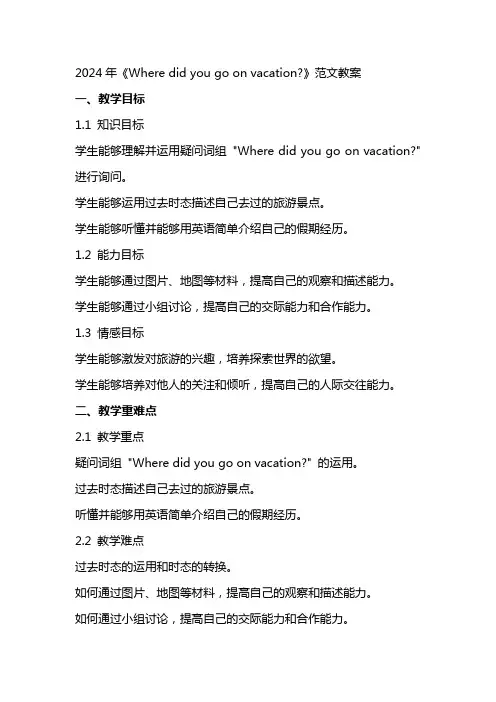
2024年《Where did you go on vacation?》范文教案一、教学目标1.1 知识目标学生能够理解并运用疑问词组"Where did you go on vacation?" 进行询问。
学生能够运用过去时态描述自己去过的旅游景点。
学生能够听懂并能够用英语简单介绍自己的假期经历。
1.2 能力目标学生能够通过图片、地图等材料,提高自己的观察和描述能力。
学生能够通过小组讨论,提高自己的交际能力和合作能力。
1.3 情感目标学生能够激发对旅游的兴趣,培养探索世界的欲望。
学生能够培养对他人的关注和倾听,提高自己的人际交往能力。
二、教学重难点2.1 教学重点疑问词组"Where did you go on vacation?" 的运用。
过去时态描述自己去过的旅游景点。
听懂并能够用英语简单介绍自己的假期经历。
2.2 教学难点过去时态的运用和时态的转换。
如何通过图片、地图等材料,提高自己的观察和描述能力。
如何通过小组讨论,提高自己的交际能力和合作能力。
三、教学方法3.1 情境教学法通过设置旅游情境,让学生在实际情境中学习和运用英语。
3.2 任务型教学法通过小组合作完成任务,激发学生的学习兴趣和积极性。
3.3 交际型教学法通过角色扮演、小组讨论等形式,提高学生的交际能力和合作能力。
四、教学准备4.1 教具准备PPT课件图片、地图等相关教学材料录音机或音响设备4.2 场地准备教室或语音室五、教学过程5.1 导入通过播放一首旅游相关的英文歌曲,激发学生的兴趣。
引导学生谈论自己去过的旅游景点,引起学生对旅游话题的兴趣。
5.2 呈现通过PPT课件,展示一些旅游景点的图片和地图。
引导学生观察并描述这些旅游景点的特点和特色。
5.3 教学通过PPT课件,讲解疑问词组"Where did you go on vacation?" 的运用。
通过示例和练习,让学生掌握过去时态描述自己去过的旅游景点。
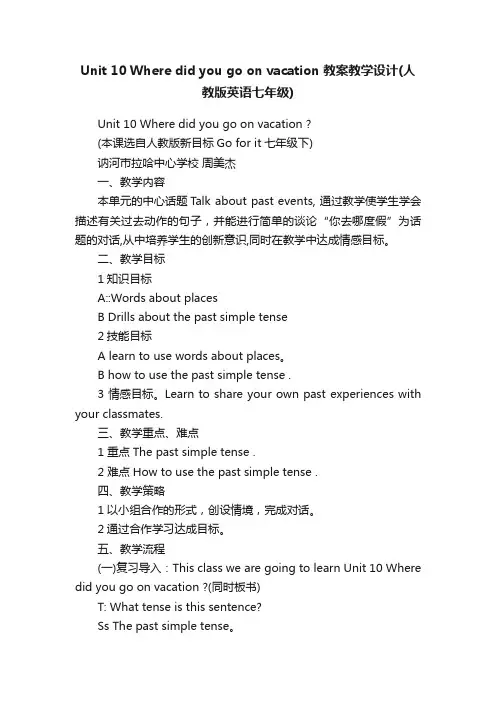
Unit 10 Where did you go on vacation 教案教学设计(人教版英语七年级)Unit 10 Where did you go on vacation ?(本课选自人教版新目标Go for it七年级下)讷河市拉哈中心学校周美杰一、教学内容本单元的中心话题T alk about past events, 通过教学使学生学会描述有关过去动作的句子,并能进行简单的谈论“你去哪度假”为话题的对话,从中培养学生的创新意识,同时在教学中达成情感目标。
二、教学目标1知识目标A::Words about placesB Drills about the past simple tense2技能目标A learn to use words about places。
B how to use the past simple tense .3 情感目标。
Learn to share your own past experiences with your classmates.三、教学重点、难点1 重点The past simple tense .2 难点How to use the past simple tense .四、教学策略1以小组合作的形式,创设情境,完成对话。
2通过合作学习达成目标。
五、教学流程(一)复习导入:This class we are going to learn Unit 10 Where did you go on vacation ?(同时板书)T: What tense is this sentence?Ss The past simple tense。
T: Good. Let’s go on learning the past simple tense。
Go over these words.first:1.clean-- cleaned2. practice--- practiced3. study-- studied-4. stop- stopped5.do---did 6 have-had 7 go---went 8 put --- put(二)创设情境:T: Where did you go on vacation ,Mali?Ss: I went to the Great Wall。
2024年《Where did you go on vacation?》范文教案一、教学目标:1. 让学生掌握询问他人度假地点的交际用语。
2. 让学生能够用英语描述自己的假期经历。
3. 培养学生的听说能力和团队协作能力。
二、教学内容:1. 核心词汇:度假、旅行、海滩、山川、景点、活动等。
2. 核心句型:Where did you go on vacation? / I went to / I did3. 范文:《Where did you go on vacation?》三、教学重点与难点:1. 重点:词汇的掌握和运用,句型的熟练运用。
2. 难点:描述自己假期经历的语言组织能力和听力理解能力。
四、教学方法:1. 任务型教学法:通过完成各种任务,让学生在实践中学习和运用语言。
2. 情境教学法:创设真实的交际情境,提高学生的语言交际能力。
五、教学步骤:1. 热身活动(5分钟):让学生自由交谈,询问彼此的假期计划。
2. 引入新课(10分钟):教师展示范文,引导学生关注核心词汇和句型。
3. 课堂活动(15分钟):学生分组,进行角色扮演,模拟范文中的交际场景。
4. 听力练习(10分钟):播放相关听力材料,学生听后回答问题。
6. 展示与评价(5分钟):学生互相展示作品,教师进行点评和指导。
7. 总结与作业(5分钟):教师总结课堂内容,布置作业(写一篇关于假期经历的短文)。
注意事项:1. 在教学过程中,要注意激发学生的兴趣,鼓励他们积极参与。
2. 对于学习有困难的学生,要给予个别辅导和鼓励,提高他们的自信心。
3. 教学中要注重培养学生的团队协作能力,让他们在互动中学习。
4. 作业的布置要结合学生的实际生活,让他们有话可说。
六、教学拓展:1. 让学生尝试用其他方式描述假期经历,如绘画、摄影等。
2. 组织一次课堂分享会,让学生展示自己的作品,并简要介绍创作思路。
七、教学评价:1. 课堂参与度:观察学生在课堂活动中的参与情况,了解他们的学习积极性。
初中英语Wheredidyougoonvocation优秀教案初中英语Where did you go on vocation优秀教案Unit 10 Where did you go on vocation?Section AⅠTeaching Aims and Demands1.Knowledge ObjectsKey vocabularyTarget languageWhere did Tina go on vocation?She went to the mountains.2.Ability ObjectTrain students’ listening, speaking, reading and writing skills.Train students’ communicative competence.3.Moral ObjectIf you have some difficulties in talking about past events, don’t worry. Practice more, and you’ll make great progress sooner or later.Ⅱ. Teaching Key PointsKey wordsThe target languageLearn to use the activities in 1a.Learn to talk about past events using the target language.Ⅲ. Teaching DifficultiesTrain students’ listening, and speaking skills.Learn to talk about past events using the target language.Ⅳ. Teaching MethodsScene teaching method.Listening and oral practice methods.Ⅴ. Teaching AidsA tape recorderA computerⅥ. Teaching ProceduresStepⅠGreetingGreet the class as usual.Check the homework.StepⅡ 1a 1b1. Each picture shows something a person did I the past. Then ask students to name each activity.2. Play a recording of three conversations. These people are talking about what they did on vacation. Listen and write the numbers of the names in the boxes in the picture.StepⅢ 1cWork with a partner, make conversations to talk about what the people in activity 1a went on vacation.StepⅣ 2a 2b1. Play a recording of three conversations. These people are talking about where they went on vacation. You are to listen and match the person with the place.2. Play the same recording again. Put a check mark under the headline ” Yes, I did.” or “ No, I don’t.”StepⅤ 2c Grammer Focus1. Place students into groups of three. Suppose one of you is Nancy, one is Kevin and one is Julie. Now please ask each other questions to talk about where you went on vacation as in the sample conversation.2. Ask students to read the questions and answers in pairs.StepⅥ 3a 3bFill in the blanks with the word “was “ or “were” .Look at the pictures carefully and try to describe each one. StepⅦ 4Works in groups and talk about their photos.StepⅧ SummarySummary the target language we’ve learned in this class. StepⅨ HomeworkWrite a short passage to talk about one of your vacations. Blackboard DesignUnit 10 Where did you go on your vacation?How was the bus trip?It was really relaxing.Where did you go?I went to the beach.How was the beach?It was beautiful.。
Unit 10 Where did you go on vacation?教案unit 10 where did you go on vacation?language goal:λ in this unit students learn to talk about recent past events. new languages:1. master the new vocabulary words.2. master the past forms of the regular and irregular verbs.3. new target language:where did you go on vacation?we went to new york city.did you go to central park?yes, i did.how was the weather? it was humid.4. be able to talk about the recent past events.difficult points:1. master the past forms of the regular and irregular verbs.2. use the new language to talk about recent past events. teaching aids:λ recorderλ some pictures of activities and placesteaching periods:λ period 1: section a 1a—grammar focusλ period 2: section a 3a—4λ period 3: section b 1a—2cλ period 4: section b 3a—self-checkperiod 1teaching aims:1. learn the new vocabulary words:2. target language:where did you go on vacation? we went to summer camp.where did he go on vacation? he stayed at home.where did they go on vacation? they visited the museum.did you/he/she/they go to central park?yes, i/he/she/they did.no, i/he/she/they didn’t.3. master the past forms of the regular and irregular verbs.4. learn to talk about recent past events.teaching procedures:step 1. warm-up2 talk about the past activities:a: how was your weekend? b: it was great.a: what did you do last weekend? b: i…a: how was his/her weekend? b: it was awful.a: what did he/she do last weekend? b: he/she…ask and answer more activities.step 2. learn the new vocabulary words1. teacher asks one student to read the new words. and see if he or she can read the new words correctly.2. practice reading the new words: repeat after the teacher; read together/in parts/one by one. then read and remember the words.3. explain some words: go to a summer camp; a central park; have a math examstep 3. presentation1. show a picture of new york city. ask “where did you go on vacation last summer?” present students to say: “i went to new york city.” then ask more students to answer the q uestion. their answers may be varied. (summer camp; went to the beach; visited museums.)2. ask some students to ask and answer the questions in pairs.a: where did you go on vacation?b: i went to the beach.practice asking and answering the conversation.step 4. 1a look and match1. the teacher reads the instructions to the students.2. students read the activities in the box first. teacher can get one student to explain them in chinese. then get students to complete by themselves.。
Unit 10 Where did you go on Vacation?单元教材分析:本课包括三部分:Section A, Section B和Self-check.主题: Where did you go on vacations.语言功能: Talk about Past events.运用一般过去时态谈论过去发生的事情。
例如:Where did you go on Vacation?。
语言结构: Past tense to like Yes/No questions and short answersAffirmative and negative statementsgo 的一般过去时,疑问句及肯、否定回答;肯定句和否定句以及在特殊疑问句中的用法语言目标:主要语法Where did you go on vacation?I went to the mountains.Main vocabulary(词汇):Central Park, exam, were, rainy, delicious,, expensive, Inexpensive, crowded, felt, corner, walk, questionnaire, discuss, sex根据需要可以分为四课时来讲。
第一课时:I.教材分析:这是本单元的第一部分,生词比较多,所涉及的是动词的一般过去时态,包括动词过去式的规则变化和不规则变化,但由于主要功能句子主要是谈论过去怎么过的假日,学生都有自己的不同经历,所以学生学习时会有兴趣去接受。
Language topic: Where did she go on vacation?She went to the mountains.Language strategies: Talk about the past eventsMain vocabulary: Central Park, exam, were, rainy, elicious,, expensive, Inexpensive, crowded, stayed at home, went to New York City.II.语言结构: like的一般现在时的一般疑问句及回答。
Unit 10 Where did you go on vacation?Part 1: Teaching Design (第一部分:教学设计)Teaching goals●Learn some new place names●Learn some description words●Learn the past tense of some verbs studied●Learn to ask and answer: Where did Tina go on vacation?She went to the mountains.Where did they go on vacation?They went to the New York City.Did you / he / she / they go to Central Park?Yes, I / he / she / they did.No, I / he / she / they didn’t.Teaching proceduresStep 1: Warming upActivity 11.Teacher lists some verbs on the blackboard.visit, go, stay, have, do, practice, am, are2.Ask students to change the words into the past forms together.visited, went, studied, had, did, practiced,Read the past forms loud.Activity 2Go on asking what you / he / she/ did last weekend using the verbs they learned.Focus their attention on the form of verbs.Step 2: Presenting1.Let students say out the verbs learnt before and teacher can help them say as many aspossible.2.Ask students: Did you stay at home yesterday?Did you stay at school last weekend?Where did you go on vacation?Where did your parents go on vacation?3.Repeat the new language points.Step 3: PracticingActivity 11. Students work in pairs. Ask and answer about where their parents, friends and theythemselves went yesterday / last weekend / on vacation.Model: A: Where did you go yesterday?B: I stayed at home. Did you stay at home?A: Yes, I did. No, I didn’t. I went to the park.B: Where did your parents go on vacation?A: They went to Beijing last month.2. Check some pairs.Activity 21.Point to the pictures in 1a. Let students talk about where the people went in pairs.Model: A: Where did the old man go in Picture f?B: He went to the beach.A: Where did the kid go on vacation?B: They went to a park.2.Check some pairs.Activity 31.Point out the numbered list of activities. Ask students to repeat.2.Then ask students to match each phrase with one of the pictures.3.Check the answers: 1.e 2.b 3. d4. c5. a6. f7.gStep 4: Listening (1b)1.Point to the picture. Ask students to tell what the person did in each scene.For example: She went to the mountains.He went to the beach.3.Play the recording the second time. Students listen and number the people 1—5 in thepicture.4.Check the answers.1.went to the mountains2.visited my uncle3. Check the answers. 1.c 2.a 3.b4. Play the recording the second time. Students listen and check “Yes, I did”or “No, Ididn’t”. as they hear them talk.5. Check the answers.Go to Central Park? Yes, I did.Play volleyball? No, I didn’t.Swim? Yes, I did.Go to the movies? No, I didn’t.Study for exams? Yes, I did.6. Students work in groups and talk about the activities in the chart and other activities.Model: Reporter: Nancy, where did you go on vacation?Nancy: I went to New York City.R: Really? Did you go to Central Park?N: Yes, I did.Ask Kevin and Julie in the same way.6. Check some pairs.Step 6: PracticingActivity 11.Ask students to say out different kinds of weather learnt before.rainy, snowy, sunny, windy, cloudy, hot, cold, warm, cool, humid2.Ask students: Wha t’s the weather like today?How was the weather yesterday?How was the weather last Sunday?How was your last Sunday?Activity 2 (3a)1.Point to the example in 3a. Read it to the class.2.Ask students to work alone and fill in the blanks in the conversation, using “was”“were”3.Check the answers.1)was 2).was 3).were 4).were5).was 6).was 7).were 8).were4. Students practice the conversation in pairs and act out.Activity 31.Point to each of the pictures and ask students to say what they see. Then read thewords under each picture. Pronounce any new word and explain the meanings ofthem if necessary.2.Students work in pairs and make their own conversations about the pictures.Model: A: How was your vacation?B: It was fantastic.A: Where did you go?B: I went to the mountains.A: How were the mountains?B: They were beautiful.A: How was the bus trip?B: It was relaxing.Activity 4Ask students to take out their photos of vacations and show their photos to the classmates and talk about their own vacations.Model: I went to Xi’an on vacation last year.It’s a very old city. The weather was sunny. My parents and I visited the BellTower. The people there were friendly --Section BTeaching goals●Master the new words: water, cry, corner, feel, decide, make, classmate, discuss, report,activity●Learn to use new sentences:We had great fun playing in the water.The shops were too crowded.I didn’t really enjoy it.I found a small boy crying in the corner.That made me feel very happy.We decided to play tennis.Teaching proceduresStep 1: Making a revisionAsk students: What did you have for breakfast / lunch / supper yesterday?How was your breakfast / lunch/ supper yesterday?Where did you go on vacation?What did you do on vacation?Guide students to answer the questions in past tense and try to use the description words they learnt before.Step 2: PracticingActivity 11.Point to the words. Say each word and let students repeat it.2.Describe the picture as a model for students:This is a ring. It’s one hundred million dollars. It’s expensive.3.Ask students to describe the other 5 pictures in the same way.4.Ask students to match the words with the pictures.5.Check the answers: 1.f 2.a 3.d 4.e 5.b6.cActivity 21.Point out the smiley face and frowny face. Say the smiley face is for good things.The frowny face is for bad things.2.Call attention to the six words in 1a. ask students to write each word undersmiley face or frowny face individually.3.Check the answers: Smiley face: delicious, cheap, not crowded.Frowny face: awful, expensive, crowded4.Students ask and answer about the 6 pictures in pairs.Model: A: How is the ring?B: It’s expensive.Step 3: Listening (2a, 2b)1.Point to the 2 questions in 2a. ask a student to read them to the class. Draw students’attention to listen to Vera talking about her vacation carefully.2.Play the recording the first time. Students listen and write down the answers to thevacation: great museum: interesting, crowdedstores: expensive people: friendlyfood: delicious6.Students listen again and repeat.7.Students work in pairs. Sa is Vera’s friend. Sb is V era. Talk about Vera’s vacation, usingthe information in the chart in 2b. Sa begins his questions with these words.Where did...?What did ...?Did you ...?How was ...?How were ...?Step 4: Reading (3a)1.Call students’ attention to Bob’s diary and give students some questions. Let studentsread the diary alone and find out the answers to the questions given.Question 1: How was the weather on July 15th / July 16th / July 17th ?Question 2: Where did he go on July 15th / July 16th / July 17th ?Question 3: What did he do on the 3 days?Question 4: How were his 3 days on the vacation?2.Check the answers.3.Explain the instructions in 3a. Then ask students to read the article alone again tocircle the good things about his vacation and underline the bad things.4.Check the answers.Good things.the weather (great)the beach (beautiful)playing in the water (fun)helping the little boy find his father (happy)playing tennis (really fun)eating Sichuan food (delicious)Bad things:shops were too crowded (didn’t really enjoy them)museum (kind of boring)no money for taxi / walking back to hotel (tired)5.Call student s’ attention to the new phrases in the diary.have fun doing sth, be crowded, find sb doing sth, be lost, help sb do sth. Make sb dosth, walk back to, decide to do sthExplain the phrases and give more examples to use them. Then let students make uptheir own sentences with the phrases above.Step 5: Writing (3b)1.Students work in pairs and talk about the places of interest in 3b.2.Students take out a piece of paper and work alone to write a travel diary, imaginingthey are foreigners on vacation in Beijing. They can go like this:Thursday, August 1stToday I went to the Place Museum. It was cool. Then I ....3.Ask some individual students to read their diary to class.Self-checkTeaching goals●Help students to review all the key vocabulary presented in this unit.●Help students practice writing a survey using the past tense.●Give students an opportunity to use the target language in conversation.Teaching ProceduresStep 1: Learning words1.Ask students to read the key words in Part 1 aloud and know the meaning of them.2.Ask students to divide the words in 3 groups.1)verbs: stayed at home, visited2)nouns: vacation, summer camp, mountain, museum,3)adjectives: delicious, awful, cheap, crowded,3.Ask students to write five or more new words in their vocab-builder.Step 2: Making a survey1.Draw students’ attention to the form and explain the instructions above it.2.Ask students to fill in the form with the information about their last vacation.3.Ask students to work in groups of four and ask their classmates questions about theirlast vacation.4.After students finished asking questions. Tell them to discuss in their groups about thebest place for a vacation.5.Ask several groups to tell the class which place they think is the best vacationdestination.。
Unit10 Where did you go on vacation ? Period ThreeⅠ. 教学内容Section B中la. 1b.lc.2a.2b.2cⅡ. 教学目标知识与水平1 Match the vocabulary:delicious, awful expensive, inexpensive, crowded2. Master and use:Where did Vera go on vacation?Did Vera like the vacation?How were the stores? They were very expensive.过程与方法通过例子The ring is one hundred million dollars.It’s expensive.引人本课,设置会话情景来激发学生兴趣,调动其学习主动性。
利用多媒体图片大量练习句型,提出问题,解决问题,体现师生互动。
情感态度价值观教育学生热爱生活,积极参与班级集体活动。
Ⅲ. 教学重、难点重点1. The vocabulary:delicious, awful, expensive,inexpensive,crowded2. language:Where did you \ they\ he\ she go on vacation?I\They \ He\She went to Japan.How were the museums/ people /stores? They were crowded expensive /friendly.难点Use the language to talk about past events.Ⅳ. 教学步骤Step 1 OrganizationOrganize Ss by greeting each other.Step 2 Presentation (1 a)Ask:What do you think of this book?Is it interesting?(通过对话弓l出本课要学习的新形容词expensive 等)Point to the picture, This is a ring. The price is one hundred million dollars.Step 3 1b writingThis activity introduces more key vocabularies.Point out the six words delicious,awful,expensive,inexpensive, crowded 1.Say each word and ask students to repeat them,2.Call attention to the fourth picture saying:This is a cake.It’s delicious!Then do the same thing for all six pictures.crowded delicious3.Then point out the blank line in front of each numbered word.4.Point out the sample answer. As students work,move around the room answering questions as needed.Answers1.f2.a3.d 4.e 5 6.cThis activity provides writing practice using the target language.Simple draw:the smiley face and the frowny face.Say,the smiley face is for good things. The frowny face is for bad things.Point out the sample answer. Say, The word delicious is under the smiley face because delicious is a happy word.Ask students to finish the activity individually,1. delicious inexpensive, crowded2. awful, expensive, crowded City some examples to learn these adjectives.This activity gives students practice in understanding the target language in spoken conversation.Step 4 Listening1.Point out the two questions. After you hear the conversation, please answer these questions. Read the questions to the class.2. Play the recording the first time.Students only listen.This time say, listen to the recording and write the answer to each question.3. listen to the recording the second time.correct the answers.1.She went to Tokyo.2. Yes, she did.TapescriptGirl:Hi, Vera , How was your vacation?Vera:It was great!Girl:Where did you go?Vera:I went to Tokyo with my family.Girl]:Really? Wow!What did you do there?Vera:Well, we went to a lot of museums.Girl:Oh, how were they?Vera:They were really interesting. But they were also very crowded. Did you meet any Japanese people?Vera:Yeah,the people were really friendly.My parents have some Japanese friends,and we had dinner at their house.Girl:How was the food?Vera:It was delicious.I love Japanese food.This activity provides furtherlistening practice using the target languageCall attention to the chart. Read the words in the chart:Her vacation, the museum the stores,the people,the food.Point out the sample answer. Say,What does Vera think of her vacation? It was great. Play the recording. Play the recording a second time.Ask students to finish filling in their answers and to check their answers.Correct the answers.Answers.Vacation---great People---friendlymuseums一interesting, crowded food-- deliciousstore一expensive delicious---relaxingStep 5 Pair work (2c Task)This activity provides guided oral practice using the target language.Call attention to the question words.Have a student read them to the class .Ask Where did you go on vacation? Say,please work in pairs.As students talk,move around the room offering pronunciation and language support as needed.Ⅴ. SummaryⅥ. 练习设计1. 词类转换1) expensive(反义词)______ 2)crowd(反义词)________ 3 ) awful(反义词)________4)friend(形容词)________ 5)go(过去式) _______ 6) do(过去式)_________ 2. 翻译下列句子1)你是去哪儿度的假?2)我们去了很多博物馆。
3) -----那儿的商店怎么样?一都很贵。
4) 日本朋友们对我们很友好。
Ⅶ. 板书设计Unit 101.delicious,awful, expensive, inexpensive2.Where did Vela go on vacation? How were the stores?。